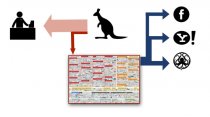 11.14.
11.14.
A few days ago VentureBeat published an article called The 7 martech buying trends shaping sales & marketing strategies in 2016, a piece of sponsored prose remarkable not for its content, but for being at least four layers of advertising removed from any kind of productive economic activity.
This is an article-length ad (1) targeted at companies selling software (2) to advertising startups (3) sellling their own ads (4) God knows where, possibly to some publishing startup burning through your grandmother's pension fund (5, 6, 7, 8).
There's an ad bubble. It's gonna blow.
The ad technology sector is extremely complicated (I believe intentionally so). Stare at this diagram for a while and see if you can figure it out. Rather than trying to follow the shell game in detail, I want to sketch an argument that follows the money in broad outline.
The set of illustrations here is drawn from a talk I gave last week in Sydney, and for that reason the consumer in the graphics below will be represented by a kangaroo.
The basic relationship, I hope, is not controversial. A customer pays money for a good or service.
 Some portion of the purchase goes to pay for advertising. The payment may be direct (a hardware store owner buys an ad in the paper) or convoluted (Sony pays a movie studio to show James Bond using their crappy cell phone). It doesn't matter what route the money takes; we just care about the net flow.
Some portion of the purchase goes to pay for advertising. The payment may be direct (a hardware store owner buys an ad in the paper) or convoluted (Sony pays a movie studio to show James Bond using their crappy cell phone). It doesn't matter what route the money takes; we just care about the net flow.
In essence, we pay a small consumption tax to fund advertising.
This diverted stream of money feeds a swamp of ad companies (several thousand at this point) with a complicated set of interlocking business relationships. These include companies producing desktop ads, mobile ads, ad brokers, marketplaces, platforms, the thriving consumer surveillance sector, and a new layer of startups specializing in defeating consumer countermeasures like ad blockers.
The balance comes out of the pockets of investors, who are all gambling that their pet company or technology will come out a winner. They provide a massive subsidy to the adtech sector.

(Not pictured in these diagrams is the massive arrow that is going to ad fraud).
The only way to make the arrows balance at this point will be to divert more of each consumer dollar into advertising (raise the ad tax), or persuade people to buy more stuff.
I doubt whether either option is viable. Compare the number of ads you see in a given day to the number of purchases you make. And consider the indirect maziness of modern advertising, with its brand awareness campaigns and social media influencers. There's not a lot of milk left in this cow.
The problem is not that these companies will fail (may they all die in agony), but that the survivors will take desperate measures to stay alive as the failure spiral tightens.
These companies have been collecting and trafficking in our most personal data for many years. It's going to get ugly.
The only way I see to avert disaster is to reduce the number of entities in the swamp and find a way back to the status quo ante, preferably through onerous regulation. But nobody will consider this.
The prognosis for publishers is grim. Repent! Find a way out of the adtech racket before it collapses around you. Ditch your tracking, show dumb ads that you sell directly (not through a thicket of intermediaries), and beg your readers for mercy. Respect their privacy, bandwidth, and intelligence, flatter their vanity, and maybe they'll subscribe to something.
Or else just sit back, crack open a cool Smirnoff Ice™, and think about more creative ways to fund online publishing.










